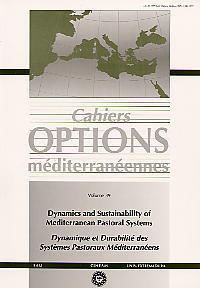| Article précédent | p. 229-233 | Article suivant |
Development of barley (Hordeum vulgare L.) as a feed-fodder crop for the Mediterranean environment of highland Balochistan, Pakistan
Local landrace of barley, susceptible to fungal disease, Yellow Rust (Puccinia striiformis) produces low yields during good production years in highland (greater than 1000m) Balochistan. Therefore, an improved variety is required for feed and food purposes. It must also withstand biotic (yellow rust) and abiotic (cold and drought) stresses. Such variety can offer a good alternate source of feed to small ruminants during winter when depleted rangelands cannot fulfil feed requirements. AZRC scientists along with ARI counterparts have released a stress (cold, drought and disease) resistant barley variety (Sanober-96) which offers a great promise for sustainable production. Sanober-96 (two row barley) gives TDM (total dry matter) 7.1 tonnes per ha and grain yield 2.1 tonnes per ha as compared to local barley's TDM of 6.1 tonnes per ha and grain yield 1.2 tonnes per ha under rainfed conditions.
- [ Afficher ]
- [ Télécharger ]
- [ Exporter la citation ]
Vous pouvez télécharger la citation au format :
- [ Imprimer ]
-
Mots-clés
HORDEUM VULGARE, PAKISTAN, PLANTE FOURRAGERE, REGION D'ALTITUDE, RUMINANT, VARIETE INDIGENECiter cet article
Khan M.A., Ahmad S., Begum I., Alvi A.S., Mughal M.S. Development of barley (Hordeum vulgare L.) as a feed-fodder crop for the Mediterranean environment of highland Balochistan, Pakistan. In : Etienne M. (ed.). Dynamics and sustainability of Mediterranean pastoral systems . Zaragoza : CIHEAM, 1999. p. 229-233. (Cahiers Options Méditerranéennes; n. 39). 9. Meeting of the Mediterranean Sub-Network of the FAO-CIHEAM Inter-Regional Cooperative Research and Development Network on Pastures and Fodder Crops, 1997/11/26-29, Badajoz (Spain). http://om.ciheam.org/om/pdf/c39/99600078.pdf



